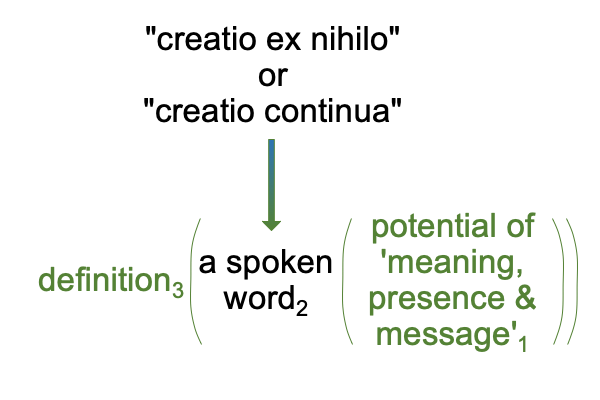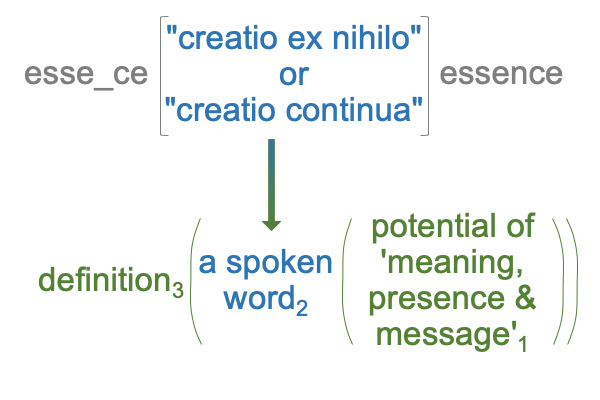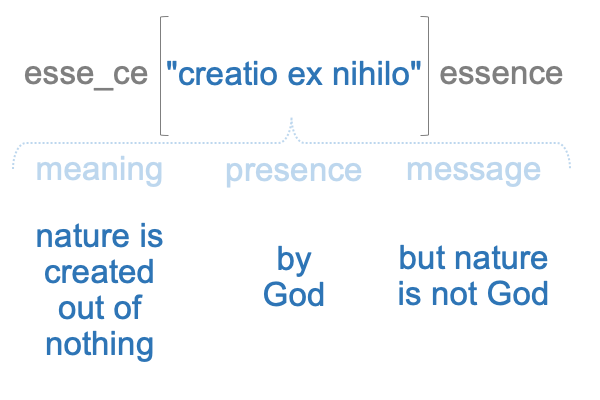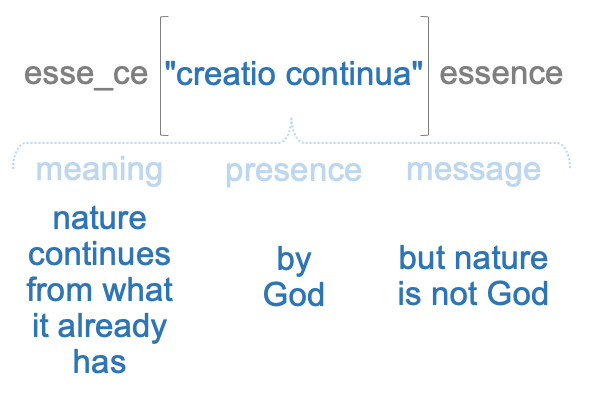0744 The salad precedes the first plate. This is a good time to play with my food. So, let me pick at what is in front of me, knowing that Tabaczek puts the garnish on the first plate in the kitchen.
0745 What is the nature of the Latin term, “creatio continua”?
Well, for that matter, what is the nature of the Latin term, “creatio ex nihilo”?
0746 In our current Lebenswelt, these are spoken words. They are explicit abstractions. Spoken words are labels that can be attached to whatever, including the contiguity between two real elements. In this instance, the two real elements are explicit abstractions. Esse_ce, being substantiating, is like a seed. Essence, or substantiated form, is like a principle.
Indeed, seed-esse_ce is like the esse_ce of esse_ces. Principle-essence is like the essence of essences. The distinction between literal and metaphorical blurs in the rarified air of explicit abstractions.
0747 In the Lebenswelt that we evolved in, our ancestors practice hand-talk and hand-speech talk. Hand-talk words cannot be used as labels that stick to whatever. Hand talk words do not permit explicit abstraction. Hand talk words picture or point to their referents. Hand-talk words facilitate implicit abstraction. This is what humans evolve to do. We overflow with implicit abstractions. Implicit abstractions turn out to be highly adaptive. They operate in every social circle, family (5), intimates (5), teams (15), bands (50), communities (150), mega-bands (500) and tribes (1500). They are built into our brains and our bodies.
0748 The expectation that linguistic hand-talk words image or indicate their referents is one of those adaptations that… well… becomes problematic in our current Lebenswelt. How does one picture or point to the referent of a spoken termsuch as “creatio ex nihilo” or “creatio continua”?
Implicit abstraction cannot do.
Yet, this is what we do.
We immediately assume that words, including spoken words, image and indicate their referents.
The mechanical philosophers of the seventeenth century attempt to routinize this innate expectation in order to firmly ground our spoken words. They attempt to write down the code for each parole, in terms of other parole. They do not realize that spoken words are merely placeholders in two arbitrarily related systems of differences, parole (talk) and langue (mental decoding of talk). Consequently, “enlightenment” dictionaries operate successfully only for a while.
New parole keep cropping up, as if out of nowhere. Old parole die and fall out of usage. Even more confusing, political operatives attach novel langue to familiar parole in order to gain political advantage.
Spoken language evolves so rapidly that French descends from Latin in only 20 generations (1000 years).
0749 So what is a scholar to do?
Well, one way to understand any actuality2 is to identify its normal context3 and potential1.
Consider a spoken word or statement as an actuality2.
Ah, Peirce’s category-based nested form is useful in understanding how we, in our current Lebenswelt, cope with the fact that spoken words cannot picture or point to their referents. The logics of normal context3 include exclusion, alignment and complement. The logics of actuality2 include the laws of contradiction and noncontradiction. The logics of possibility1 are inclusive and allow contradictions.
A relevant category-based nested form is developed in Razie Mah’s masterwork, How To Define the Word “Religion”.
0750 Here is a picture of what I am talking about.

0751 Obviously, the picture is a little complicated.
Why?
Creatio ex nihilo and creatio continua each constitute a continuity between two real elements: esse_ce and essence.
Plus, when these Latin terms are spoken, no one utters anything about esse_ce or essence, even though they are the real elements that these Latin terms bind together.

So, I am working in unknown territory, which sounds very much like a “salad” to me.
Surely, Tabaczek is cooking up something delicious.
0752 Now, what is the potential1 underlying the term2?
Here is my speculation for creatio ex nihilo.

Clearly, the logic of firstness is inclusive and allows contradictions.
But, this application is particularly goofy.
Nevertheless, the potential1 supports the actuality2 quite well.
Nature is the meaning of creation. Nature is present because God created it from nothing. But, nature is not God.
0753 What about creatio continua?
Well, once nature is created, then continued creative (and destructive) activity continues because nature can adjust, modify, tweak, simplify, increase and diminish what it already has.

0754 Of course, the meaning, presence and message underlying the spoken word, “creatio continua“, exhibit a certain vulnerability.
Does a scientist need to posit the presence underlying the term?
If the answer is “no”, then all that is needed is to refurbish that stuffy old Latin term into something that sounds much more modern.
How about the word, “evolution”?
Moderns replace the presence underlying the term, creatio continua, with the label, “made by evolution”.
